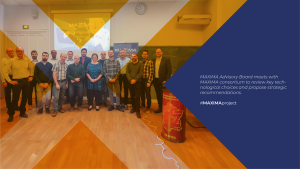
The Maxima Consortium recently convened a crucial meeting with the Maxima Advisory Board, bringing together industry experts and academic leaders to review key technological choices, address ongoing challenges, and propose strategic recommendations for the project’s management and design process. Held on September 18th, the meeting focused on assessing the project’s progress and exploring new technological avenues to drive the Maxima project forward.
Key institutions participated, including École Nationale Supérieure d’Arts et Métiers (ENSAM), Stellantis, Emotors, 4Multiphysics (4MP), Universitat Politècnica de Catalunya (UPC), Technical University of Cluj-Napoca (UTCN), and Université de Lille (Ulille).
The discussions opened with a presentation from Stéphane Clénet, project coordinator, (ENSAM) and M’Hamed BELHADI of Stellantis, outlining critical Key Performance Indicators (KPIs) for the project. These included achieving a continuous torque density of 20N.m/kg and reducing losses by 20% compared to a reference motor. This set the stage for the technical goals that the consortium must meet to succeed.
Following this, Claudia from UTCN presented the global design methodology, emphasizing the importance of interdisciplinary collaboration and effective integration across the different teams involved. Her presentation highlighted the structured approach that is driving Maxima’s complex development processes.
An in-depth exploration of electromagnetic design was led by Abderrahmane REBHAOUI from Emotors. Here, the advisory board engaged in detailed discussions on refinements and challenges, providing valuable feedback to further optimize system performance in line with the project’s KPIs.
Next, Sergiu Marciuc from 4MP addressed the project’s thermal design challenges. He discussed strategies for improving energy efficiency by reducing losses during vehicle operation, with a specific target of 2% energy consumption reduction through advanced control strategies like optimal electromagnetic control.
On the mechanical front, Claudiu Cotovanu from 4MP introduced solutions that ensure both durability and the use of lightweight materials. His team is working on the development of two prototypes (60 kW and 120 kW), aimed at covering the market targeted by Maxima. These prototypes will be tested in industrial environments to validate their design, manufacturing process, and recycling flow.
Ioan DEAC from Emotors then shifted the focus to manufacturing and recycling considerations, aiming to keep material and production costs below €6/kW. He highlighted the consortium’s goal of achieving a recyclability rate of over 60%, focusing on recycling 100% of permanent magnets without extracting single rare elements—an effort aligned with Maxima’s eco-design framework and environmental impact objectives.
The advisory board, composed of distinguished experts such as Marc Tuzini (Founder of OCCITEM), Univ.-Prof. Dr.-Ing. habil. Kay Hameyer (Institute of Electrical Machines, Aachen University), and Christophe Viguier (Senior Expert, Safran Tech), provided insightful feedback on the technological choices and challenges addressed in the meeting. They offered strategic solutions to unresolved issues, introduced potential new technologies, and shared recommendations on best practices for managing the design process efficiently.
This meeting marked a significant milestone in the Maxima project’s development, paving the way for further advancements in both design and technology. The consortium, with continued guidance from the advisory board, remains committed to driving innovation and ensuring the success of the project through collaboration and expertise.
Stay tuned for future updates as Maxima continues to lead groundbreaking efforts in the field of electrical mobility!
